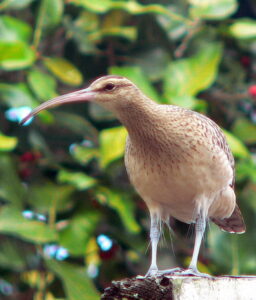
A Bristle-thighed Curlew at Sand Island, Midway Atoll. © Susan Scott
March 18, 2023
I’ve only recently come to appreciate what a privilege it is to see and hear the shorebirds we call kioea, or Bristle-thighed Curlews. Through the 1990s, I lived near the Waialua sugar mill’s settling ponds, where the curlews hung out, and thought the birds were common. Later, my encounters with curlews during my work at Midway and Palmyra Atolls boosted my belief that the birds are abundant.
Not so. The entire world population is about 10,000. But lucky for us bird admirers, the Hawaiian Islands are one of the kioea’s favorite wintering sites, as are islands of the South Pacific. The kioea is the only migratory shorebird that winters exclusively on Pacific Islands.
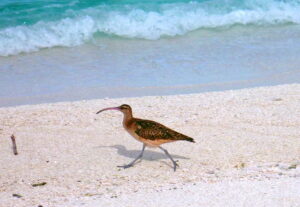
A kioea foraging on a Sand Island beach, Midway Atoll. ©Susan Scott
Given their astonishing flying feats, all migratory shorebirds are extraordinary. Among them, however, kioea stand tall. Literally. The Hawaiian word kioea means stand tall, or long-legged, and kioea are. Researchers don’t usually measure birds’ heights, but rather report size in length, from the top of the head to the tip of the tail. In that, kioea measure 16-to-17 inches long. (For comparison, our kōlea are about 10 inches long.) Because kioea stand head and shoulders above other shorebirds that spend winters here, kioea are easy to spot in a crowd.
Another instant ID are the kioea’s four-inch-long, downcurved bills, perfect for probing, picking up, and eating insects, spiders, fruits and flowers. When those are scarce, the resourceful kioea eat any plant or animal they find, dead or alive. The abundant nonnative red swamp crayfish and apple snails thriving in the James Campbell National Wildlife Refuge ponds (see my last post) must seem to the curlews like an all-you-can-eat buffet.
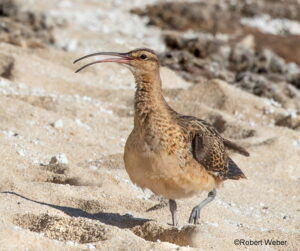
Bird tours are great places to make friends. I met biologist and photographer, Robert Weber, several years ago on a manu o kū tour in Waikiki, and we’ve kept in touch. When he learned that I was interested in kioea, Robert shared his excellent photos of Oahu’s North Shore kioea. You can see Robert’s other outstanding photos here. ©Robert Weber
Those long strong bills are also excellent tools for catching lizards, crabs, mice, and rats. When a meal is too large to swallow, the kioea slams it over and over on hard ground or against rocks until it breaks into bite-sized pieces. Kioea are also famous for using tools. The curlews throw stones to break open the eggs of albatrosses and other ground-nesting birds.
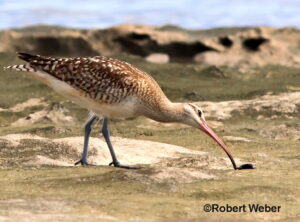
Kioea poking at a cowrie. Oahu, near Kahuku. ©Robert Weber
Ancient Hawaiians also called a Hawaiian honeyeater kioea. Endemic to Hawaii Island, the kioea honeyeater was already rare when first described in 1848. Researchers of the era caught the last specimen in 1859. At an unknown time after that, the species went extinct.
The Bristle-thighed Curlew’s odd English name comes from long feather shafts on the bird’s thighs that stick out below the birds’ belly feathers. I imagined these extensions as brittle, like the center stems of feathers, but one researcher describes the bristles as silky. Their purpose is not known.
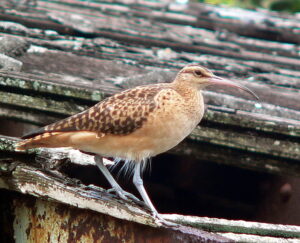
The kioea’s so-called “bristle-thighs” are soft feather shafts. Their function is a mystery. ©Susan Scott
Speaking of feathers, kioea is the only shorebird that loses its ability to fly during the spring molt, when the bird sheds its winter feathers, and grows in brighter-colored ones. Being unable to fly wasn’t a problem before humans introduced predators to islands throughout the Pacific. Now during their flightless time, curlews are vulnerable to cats, rats, dogs, and mongooses.
Like other shorebirds, kioea are masters of migration, flying in late April-early May about 3,700 miles nonstop from Pacific island wintering sites to far north Alaska breeding grounds. Like kōlea, kioea return to their tropical islands in late July and August.
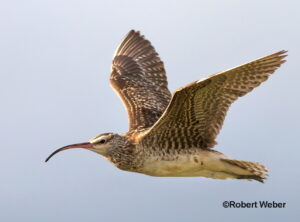
Kioea share the honor with Bar-tailed Godwits of making one of the longest nonstop migrations of any known bird. Kioea in flight. North Shore, Oahu. ©Robert Weber
In learning more about these birds, I see that I’ve been taking my encounters with Bristle-thighed Curlews far too much for granted. Now when I see a kioea standing tall with other migratory shorebirds, I know I’m seeing a celebrity among celebrities. If I get lucky, I’ll get to see one clobbering a crayfish or slamming a snail.
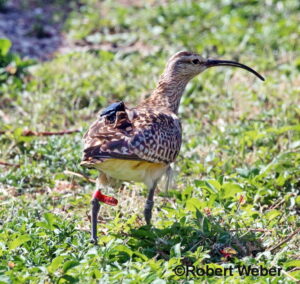
Speaking of celebrities. Robert didn’t see these this bird’s backpack until he downloaded the photo, taken near Kahuku in May, 2021. The red leg tag is a visual ID. The black device is an ICARUS transmitter placed by French researchers on Rangiroa, the largest atoll in the Tuamotus. ICARUS is the satellite tracking system: International Cooperation for Animal Research Using Space. The French 2021-2022 study of several species is here. ©Robert Weber.